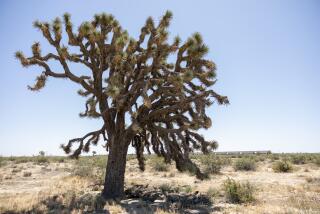Yosemite’s Sequoias have a vital message. Listen to them, urges Terry Tempest Williams
This essay, “The Liturgy of Home,” is an excerpt from “Erosion,” a new collection by Terry Tempest Williams. Her previous works include “The Hour of Land: A Personal Topography of America’s National Parks” (2016) and “When Women Were Birds” (2014). Williams received the Los Angeles Times Book Prizes’ 2018 Robert Kirsch Award for lifetime achievement, which recognizes a writer whose work focuses on the American West.
“The plain fact is that the planet does not need more successful people,” David Orr writes. “But it does desperately need more peacemakers, healers, restorers, storytellers, and lovers of every kind. It needs people who live well in their places. It needs people of moral courage willing to join the fight to make the world habitable and humane. And these qualities have little to do with success as we have defined it.”
What are the qualities most needed in this epoch of the Anthropocene?
One of the qualities we might seek to cultivate is our capacity to listen.
Sue Beatty, a lead biologist at Yosemite National Park, now retired, offers an example. We met in 2016 inside the Mariposa Grove, where she told me this story:
To remember why she does her job, two or three times a week, Sue would walk through the Mariposa Grove, where the Giant Sequoias are known to be between two thousand and three thousand years old. She would imagine what they have lived through and witnessed. But one day, when she was walking through, her normal pattern of thought was disrupted. I imagined the Big Trees speaking to her: “We are suffering. We are dying. Can you hear us?”
What she saw in the grove were roots trampled and soil erosion in the extreme. She looked up and saw how the Giant Sequoias were continuing to grow larger in spite of the road being only a foot away. People were parking their cars on the roots of the big trees. She noticed how the surface water was being diverted through roadside ditches away from the trees. And she wondered what actions she and her team could take to help alleviate their suffering.
Sue would tell you I am giving her too much credit, that this was a collaborative effort with her project management staff. Perhaps that is true, but I would tell you she is a modest human being whose sensitivity to the sequoias made all the difference. Sue Beatty had a vision of restoration.
“As a group we discussed what was needed to start planning for a restoration of the grove,” she said. “I proposed along with Kimball Koch, the project manager, that we needed a comprehensive analysis of the Mariposa Grove: a complete inventory of the Giant Sequoias, wetland mapping, a hydrologic look at water diversions of roadside ditches, wildlife surveys of rare species, an anthropological study, and an evaluation of how visitors were currently using the grove.”
Which is what they did. They gathered this information on the sequoias’ behalf, which helped provide the basis for the planning effort to improve the habitat for the Giant Sequoias, in the belief that it would also improve visitors’ experience.
What was wrong? Since the Mariposa Grove’s protection by President Abraham Lincoln as part of the Yosemite Land Grant Act of 1864, millions of people’s feet had been tamping down the sequoias’ roots. Roads and buildings had been encroaching on their root systems.
The Big Trees were suffocating; they could not breathe. The xylem and phloem were not flowing properly. Neither were the natural waterways and wetlands.
What did Sue and her team recommend? Removing all the pavement in the grove so that the fragile root systems could heal; restoring some semblance of stillness to the chaos of park visitation. Roads would be realigned. A different vision would be sought. The Mariposa Grove would no longer be a place of entertainment and recreation, but a place of reverence and restoration. No more trams, no more vans, no more cars but rather seekers who could hold the quiet with the sequoias.
The planning team took this data and their recommendations to the superintendent and management team of Yosemite National Park, who listened. Together, they discussed with the leadership within the National Park Service the most ambitious restoration project in the history of Yosemite. The proposal for the restoration of the Mariposa Grove was approved. Forty million dollars was raised, much of it from citizen donations.
And for three years, the big trees rested: The trams stopped; the parking lot was removed and relocated two miles away; visitors were redirected to other places in the park; and miles of asphalt were removed, roads taken out that impinged on the trees’ root systems and replaced with gentle walking paths and trails designed for the ecological well-being of the trees; wetlands and waterways were restored; all commercial activities, from the gift shop to tram rides, ceased and were relocated elsewhere in the park.
Sue Beatty and her team listened to the land and responded not only from what they knew as scientists, but from what they imagined as individuals who cared. The status quo was no longer acceptable. The possible became the necessary. The Giant Sequoias were not objects to be studied, but sentient beings recognized as venerable members of the Yosemite community. Beatty and her colleagues acted by using the gifts that were theirs and changed the landscape on behalf of the Big Trees. The entire forest community benefited.
In the summer of 2018, the public was invited back to pay their respects to the Ancient Ones. Peace and stillness have been restored. Now, when you walk into the Mariposa Grove and stand before these great beings, you are met with an invitation: Can you hear the trees speaking?
Are we listening?
This is the Liturgy of Home.
There is only one moment in time
When it is essential to awaken
That moment is now.
—Buddha
This does not require belief, it requires engagement.
How serious are we?
Excerpted from “Erosion: Essays of Undoing” by Terry Tempest Williams. Published by Sarah Crichton Books, an imprint of Farrar, Straus and Giroux Oct. 8 . Copyright © 2019 by Terry Tempest Williams. All rights reserved.
More to Read
Sign up for our Book Club newsletter
Get the latest news, events and more from the Los Angeles Times Book Club, and help us get L.A. reading and talking.
You may occasionally receive promotional content from the Los Angeles Times.







